On View
In Saudi Arabia, a Calm, Meditative Biennial Defies the Uproar as Desert X AlUla Organizers Say the ‘Dust Is Settling’ on the Controversial Show
Can Desert X AlUla ever separate politics from art?
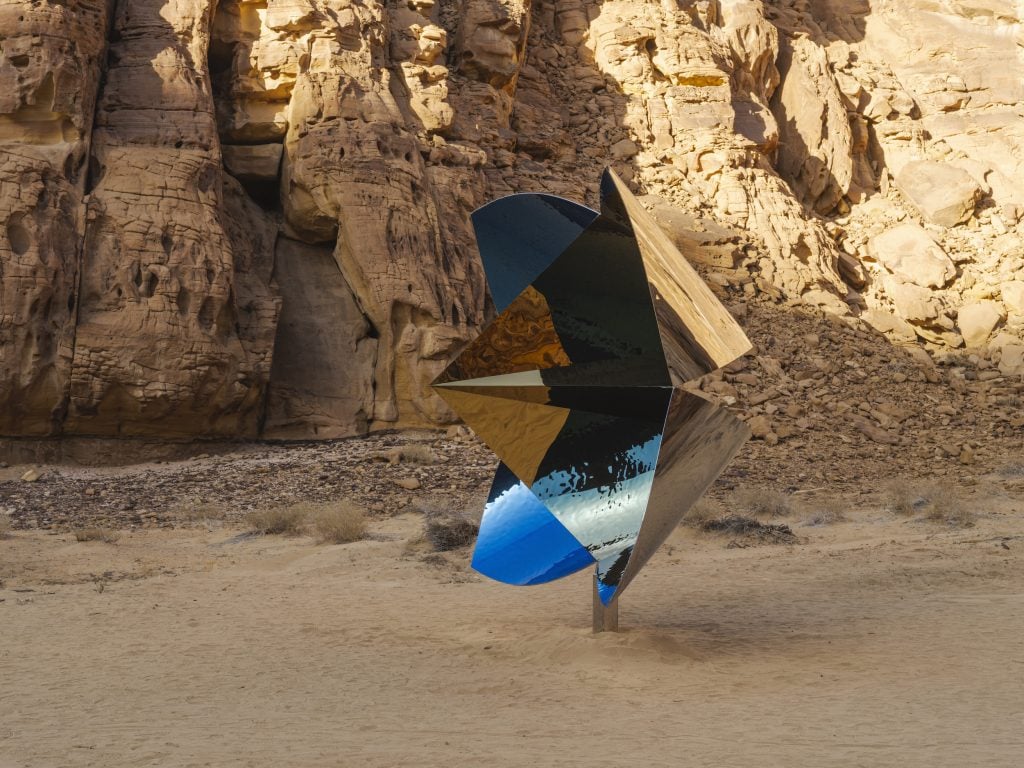
Can Desert X AlUla ever separate politics from art?

Rebecca Anne Proctor

Lita Albuquerque’s electric blue sculpture of a woman, seated in a meditative lotus pose, sits atop a gigantic rock overlooking the sand in AlUla, Saudi Arabia’s ancient desert region. Now the work, which was installed during the first edition of Desert X AlUla in 2020, and purportedly marking the first public showing of a female figure in the kingdom, can be viewed from a pool lounger at a new eco-friendly luxury resort, Habitas AlUla.
Albuquerque’s sculpture, titled NAJMA, is symbolic of Desert X AlUla’s historic launch two years ago. The woman’s calm focus against her breathtaking natural backdrop, is reflective of the country’s determination to build an art ecosystem in AlUla, despite the chaos and controversy that surrounds it, including the ongoing war with neighboring Yemen, boycotts over the murder of journalist Jamal Khashoggi, and other human rights violations.
Despite the global pandemic, Saudi Arabia, closed off to the world for decades, has continued its ambitious plans for development, which are part of Crown Prince Mohamed bin Salman’s “Vision 2030.” Desert X AlUla, which takes its cue from the Land Art movement of the late ‘60s and ‘70s, is a major part of that agenda. This year the biennial, which was organized again in partnership with the Saudi Royal Commission of AlUla, features commissioned work by 15 international artists (open now until March 30).
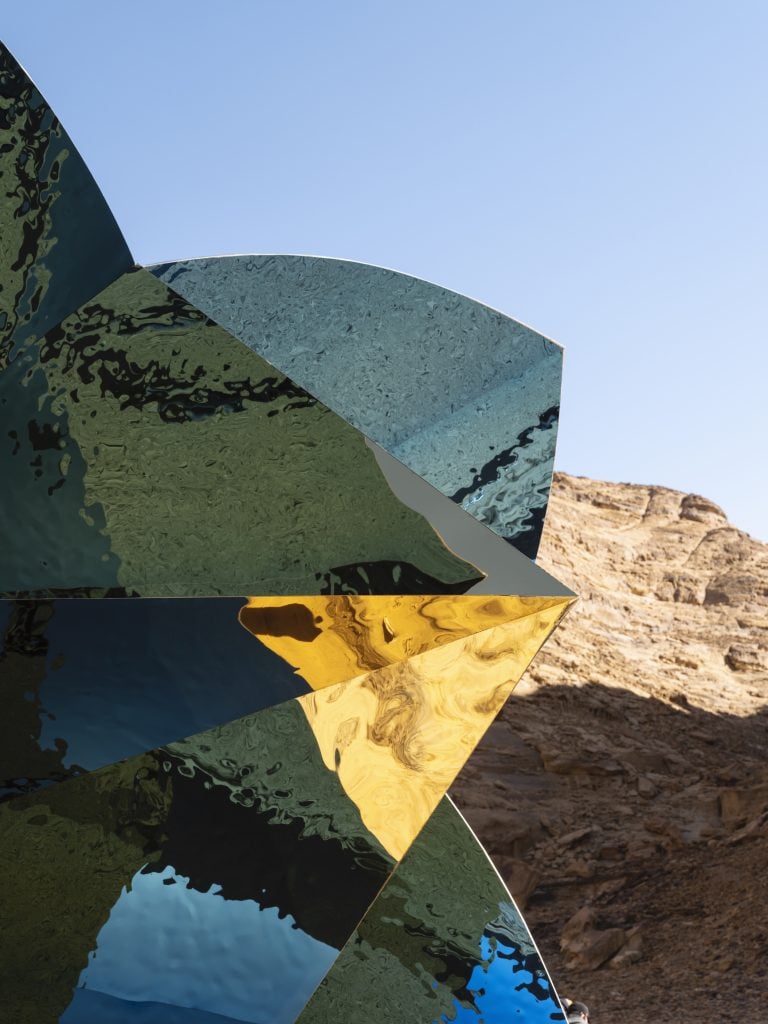
Shadia Alem, I Have Seen Thousands of Stars and One Fell in AlUla (2022). Photo: Lance Gerber.
The message, say Desert X organizers, is the same in Saudi Arabia as it is in the biennial’s other site, the Coachella Valley: Focus on the art, its relationship with the land, and the plurality of artistic voices and cultures represented.
“The mood now is that the artists don’t need to explain themselves anymore,” Reem Fadda, a curator of the 2022 edition alongside Neville Wakefield and Raneem Farsi, told Artnet News. “There is no need for anyone to explain or defend themselves. They are here to speak their minds, concerns, and anxieties that are universal. The artists have nothing to prove.”
Some participating artists also spoke of wanting to look beyond the government’s actions. “You have the choice to engage in dialogue and change the narrative or push it forward or not,” artist Shezad Dawood told Artnet News. “There was something about the particular situation in AlUla, the ancient civilizations, the geology, those are all things that interest me.”
But while frustration and backlash, particularly from the United States, still linger, Susan Davis, Desert X’s president and founder, said that “the dust is settling.”
“Overall, there have been many disappointments, not in terms of the art, but because every story that ran last time dug for the negative,” she said. “This is not the journalism I grew up with in the United States. It’s about what is the easy story, not what is the interesting story or what are the two sides of the story. It’s heartbreaking.”
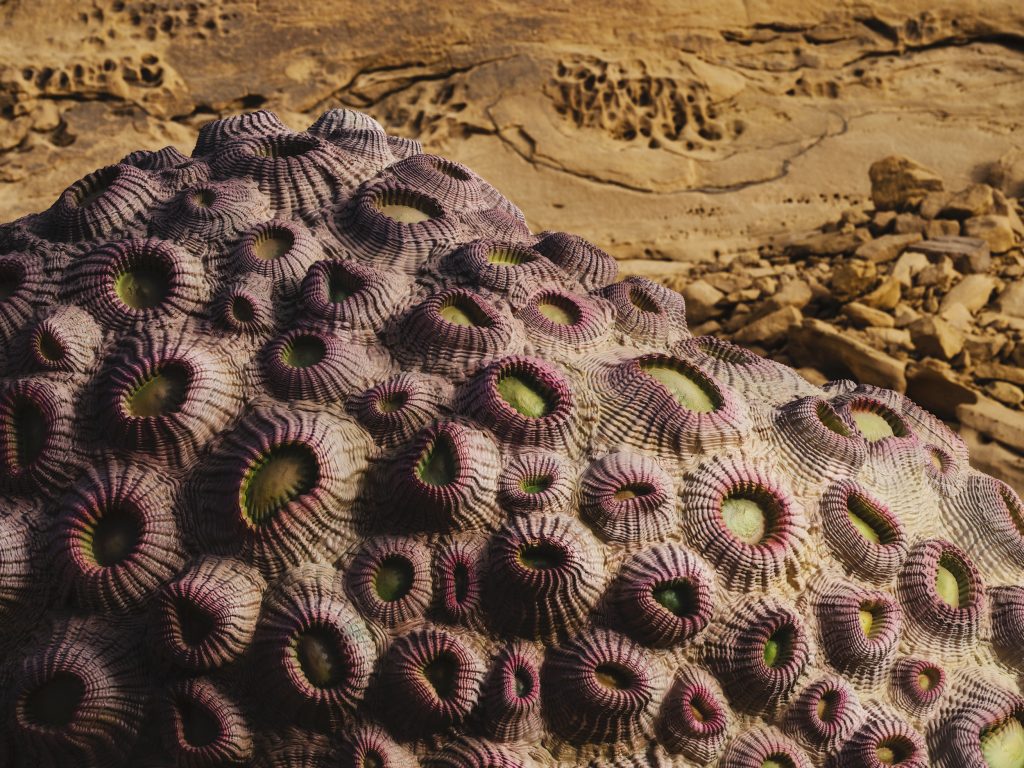
Shezad Dawood, Coral Alchemy I (Dipsastrea Speciosa) (2022). Photo: Lance Gerber.
Despite its critics, the seeds are being sowed in AlUla for a future art ecosystem, and the biennial can arguably be viewed as a catalyst.
This year, the event is part of the first edition of the AlUla Arts Festival, where six international artists who are part of the AlUla Arts Residency have created work in-situ amid a verdant oasis. There’s also a photography exhibition in AlUla Old Town, a show at the Maraya Concert Hall featuring works by Saudi artists, and Swiss art collector and long-time Saudi resident Pierre Sigg’s newly launched Sigg Art Residency AlUla—the only independent, private initiative in the otherwise government-funded lineup of events.
The desert is the real curator of this edition of Desert X AlUla, which is now taking place in a larger location, the Al Mutadil valley. Staged under the theme of “Sarab,” meaning “mirage” in Arabic, the works, which were created freely without any guidelines by the organizers, are anchored in history, literature, and the physical reality of being in the desert. The art embodies man’s desire to control nature, but also nature’s elusiveness—which, as so many works demonstrate, usually escapes human command.
The artworks are subtler, more unassuming, humbler, and smaller in some instances than the more grandiose creations of the first edition. This year’s works interact and collaborate with the thousands of year-old rock formations, rather than compete with it.
“No work can beat the greatest artwork here, which is the surroundings—the rock art formations themselves,” Dawood told Artnet News.
“It’s a lovemaking with nature,” Fadda said during the press conference.
The artworks relay messages on climate change, human progress, the land, and ancient history. “We are living in a time of climate emergencies and places like AlUla are precious,” said Wakefield. “The works shed light on topics important to the desert but also to the world at large.”
Dawood’s large coral-like forms, Coral Alchemy (Dipsastrea Speciosa), seem to have landed like a meteoroid from outer space. While one is prominently placed, the other is embedded high up within a rock formation, its color nearly matching its surroundings. Through the works, Dawood explores the idea of the geo-biological relationship between the desert floor (at one time most of AlUla was underwater) and the nearby Red Sea. Moreover, the sensitive surfaces of the works change color according to heat reflected from the sun.
Further up, Palestinian artist Khalil Rabah’s Grounding presents a mirage of olive trees—which do not grow in AlUla. Displaced from their indigenous land and longing to be repatriated, the trees represent the Palestinian crisis.
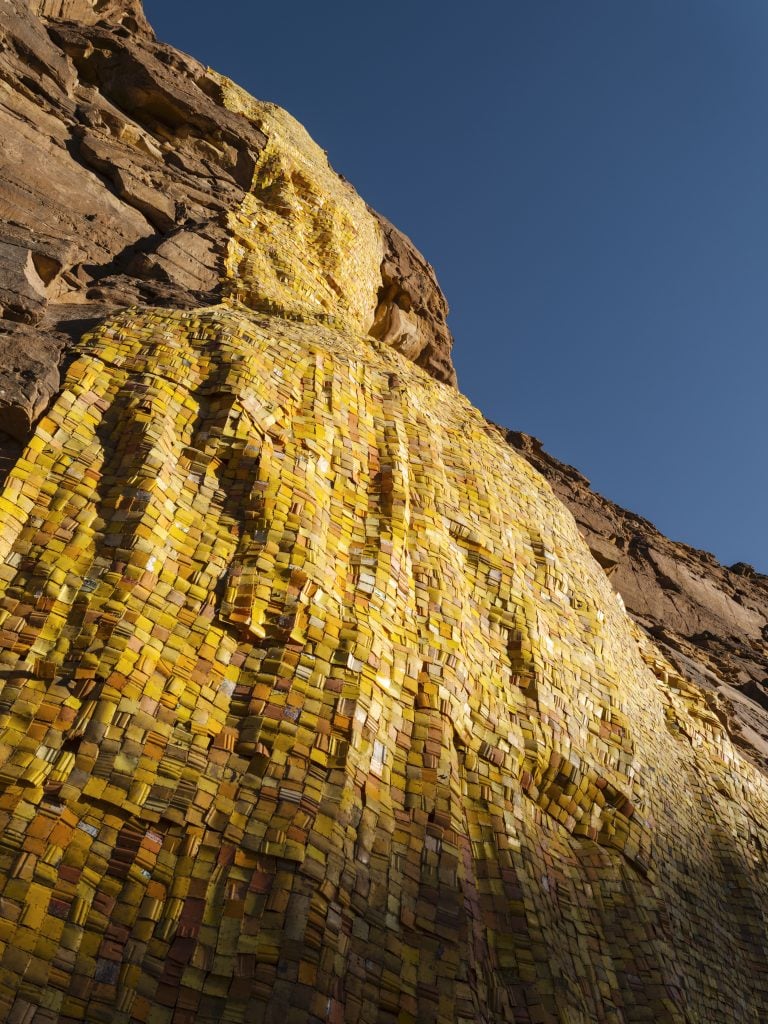
Serge Attukwei Clottey, Gold Falls (2022). Photo: Lance Gerber.
An unmissable sight is Gold Fall, a long tapestry-like work made of cut squares from yellow plastic water containers draped over a rock formation by Ghanaian artist Serge Attakwei Clottey. The artist, who exhibited previously at Desert X Coachella, is the first and only African artist in the AlUla edition. While discussing the politics of the ubiquitous yellow water gallon in West Africa, the work, the artist explains, is also about forming a friendship with the desert.
“The history of the desert from an African perspective represents struggle, death from migration, water scarcity, and sadness,” Clottey told Artnet News. “But having an exhibition in the desert brings life and humanity to the place and to nature. Using the gallon here as a representation of water scarcity, I wanted to change the perception in this space as to how water can represent hope and life.”
Participating in the exhibition, added Clottey, is a way to see more African artists represented internationally.
The curation of the works is tighter and more thought out than the first edition, where the air felt more revolutionary and celebratory. Works have been placed in dialogue not just with nature but with each other.
In front of Clottey’s water gallon are the 364 pyramid-shaped concentric sand mounds of American land artist Jim Denevan’s Angle of Repose. Made in collaboration with local AlUla residents all who volunteered, the magnitude and repetitive nature of the circles, which become smaller as one enters the center of the work, is at once otherworldly and distorting in vision—both aims of Denevan’s as he tries to shape the visitor’s experience in the desert.
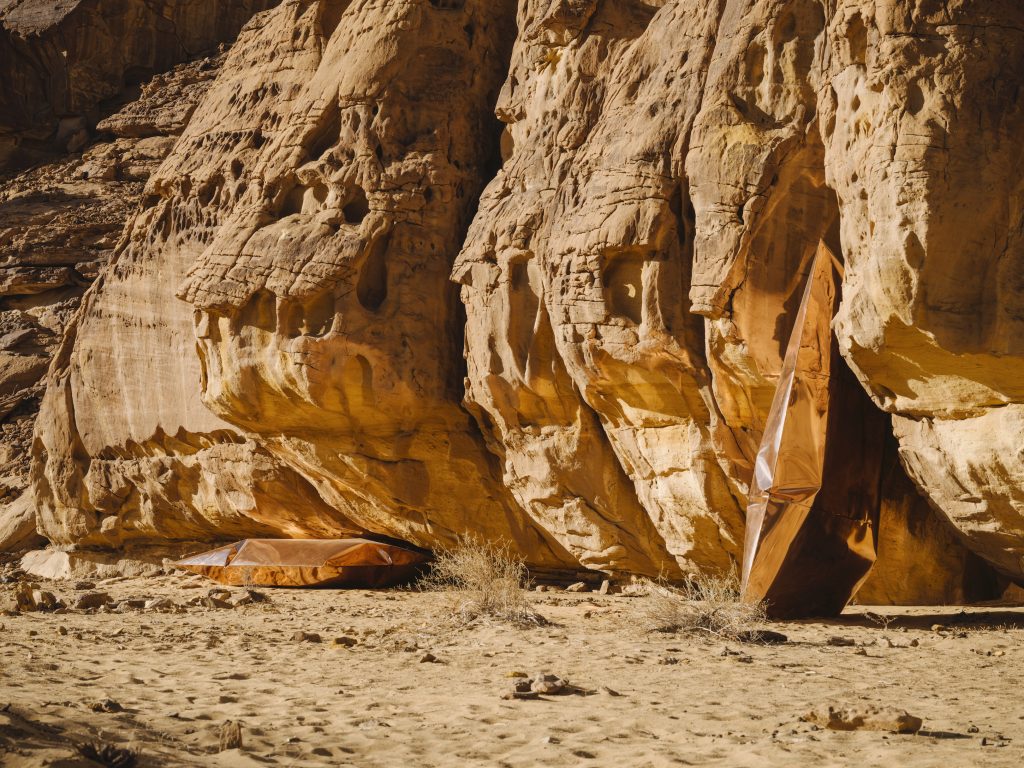
Shaikha Al Mazrou, Measuring the Physicality of Void (2022). Photo: Lance Gerber.
Behind Denevan’s majestic sand creations are the lengthy steel-made inflated sculptures of Emirati artist Shaikha Al Mazrou, titled Measuring the Physicality of the Void, wedged into voids within the rocks. Tensely balanced in the landscape, if it weren’t for their shiny surfaces, one might not know they were there. Further up is Saudi artist Abdullah Al-Othman’s Geography of Hope, a gigantic anamorphous-shaped flat steel work that replicates a body of water. According to the artist, it represents the experience of a mirage, and the hope that it brings in the desert when one might have lost their way.
The act of viewing the works in Desert X is physically laborious, which adds to the experience. To reach Saudi artist Ayman Zedani’s soundscape and installation, The Valley of the Desert Keepers, one must walk up a steep rock following long yellow and green rope. The sound of crunching rocks, akin to that of glass, conjures up its own kind of music that immediately merges with Zedani’s recording of an Arabic narration of the names of desert plants, blasted through speakers on the rock. The experience is at once meditative and surreal, and when one looks over the crevice, Claudia Comte’s Dark Suns Bright Waves appears—a line of large rectangles with black-and-white stripes exploring the patterns found in nature.
Works by Saudi artists delve deep into the ancient histories of AlUla. Palestinian Saudi-born Dana Awartani’s concave geometric structure made from sandstone, Where the Dwellers Lay, takes its inspiration from ancient Nabatean tombs in AlUla. It invites viewers to take a seat inside the work, as if it were a tomb or a throne, where they can appreciate the art and the surrounding space.
Sultan bin Fahad’s mud structure, made in collaboration with local AlUla residents, entered from a long pathway into a circular enclosed space where a glass sphere shape, embossed with four protective symbols used in Nabatean tombs, points to the sky. It pays reverence to the history of the Desert Kite, after which it takes its name.
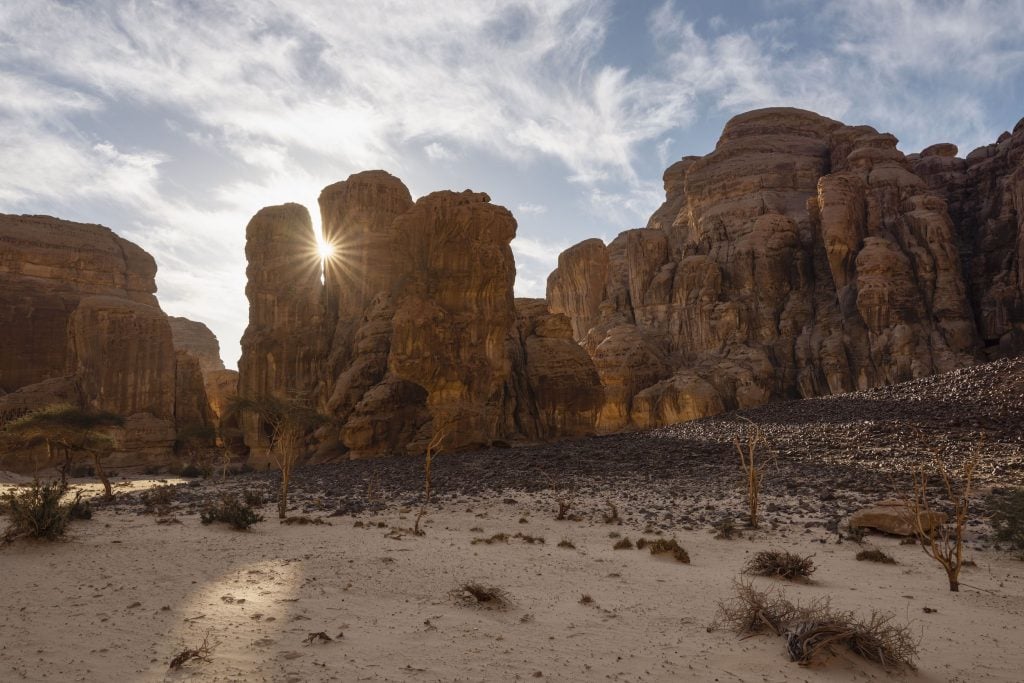
Desert X AlUla landscape. Photo by Lance Gerber, courtesy RCU and Desert X.
“This is where you need to come on your own to meditate and become one with the history and the land,” the artist said.
But who will come to meditate and contemplate next to these artworks? The elegantly clad art world crowd arrived on February 10, Desert X AlUla’s VIP opening. Among them was Alicia Keys who was to sing the following day at the Maraya Art Center. She twirled in the center of Denevan’s sand mounds, her white dress echoing that of a whirling dervish as onlookers snapped her photo.
Will the audience for these monumental artworks be limited to the few that can afford the journey to view their magic?
“Many Saudis will come,” said artist Moath Alofi. “There are now direct flights from all over the Kingdom to AlUla. We come all the time.”
By 2035 AlUla aims to be able to welcome just two million people annually—a controlled number for a region nearly the size of Belgium so it does not transform into a mass tourism hub.
Perhaps the work that most acutely points to AlUla and its artistic rebirth after thousands of years is Saudi artist Shadia Alem’s shimmering star sculpture, I have seen thousands of stars and one fell in AlUla.
In the shape of a giant origami, it glistens in the sand as if foretelling a prophecy for the area, symbolizing death just as it does rebirth—a cycle of change and renewal—like life itself, and like the present state of Alula as it rises once again.